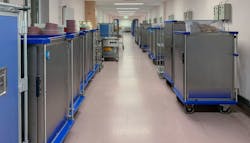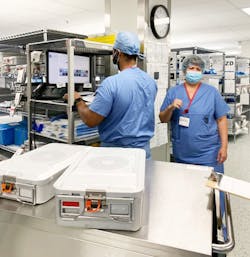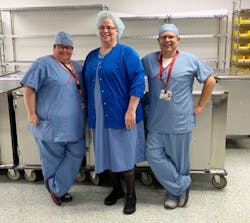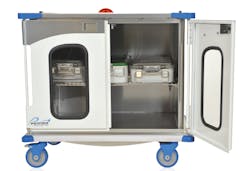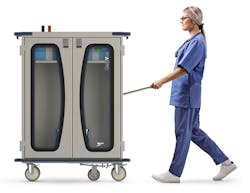The case for conformity, collaboration in managing case carts
The Central Service/Sterile Processing & Distribution (CS/SPD) and Operating Room (OR) teams’ processes are critical to the healthy functioning of both departments. Because their processes touch in many places, and an action, good or bad, can have a small or significant impact on the other, it is common to hear CS/SPD and OR team disagreements, finger pointing and, in some cases, outright distain for one another.
On the flip side, successful relationships among CS/SPD and OR team members have been shown to improve processes across both departments, contributing to safer patient care, greater efficiency, and a healthier work environment all around.
With case carts traveling from the CS/SPD to the OR and back to the CS/SPD again, there are plenty of opportunities for collaborative improvements throughout their journey. Let’s look at two success stories of case cart collaboration, along with factors for consideration when choosing case carts that meet both the needs of CS/SPD and OR teams.
Visibility drives Mount Sinai West NYC case cart success
Case carts were a “logistical nightmare,” says William DeLuca, Director of Sterile Processing at Mount Sinai West NYC, causing bad relations between the CS/SPD and OR teams and extreme stress for everyone involved.
“My team would have 9:30 a.m. and 2:30 p.m. huddles with the OR nurse managers each day and everyone dreaded them,” said DeLuca. “When we had a rough day, we knew they were really going to let us have it.”
Determined to get down to the root cause of the issues, DeLuca began attending the huddles himself to show the OR team that he was “serious and committed” to improvements. To understand the challenges his staff was facing firsthand, he worked each of his department’s three shifts side-by-side with managers and staff members, performing the same work they do.
“When picking cases I noticed a variety of issues, such as where case carts were stationed, where packs were stored, the location of high use trays, and how they picked the cases,” said DeLuca. “It is a big department, so logistics are important. My staff had to travel from the sterilization area to the storage area then from the case cart area to storage, which were all far away from one another.”
With input from his team, DeLuca decided to make several logistical changes that have had a huge impact on the efficiency and effectiveness of the department and how it serves the OR.
- Color-coded the entire department by service line (e.g., Ortho: Beige, Neuro: Black, etc.)
- Labeled racks by service line (e.g., Ortho: 1-20, Neuro: 21-25, etc.)
- Moved the 10 most used items to be stationed as close as possible to the case cart and sterilization areas, making it a very short trip from storage to the case cart area to case picking
- Properly labeled packs so even new employees picking cases could easily and quickly find what they needed
- Placed packs as close to the case picking area as possible
Recognizing how preference card formatting also contributed to confusion and inefficiency, the CS/SPD manager suggested to DeLuca they take a new approach. Previously CS/SPD staff members would label each completed case cart with a print up from the physician’s preference card, including the OR location and time for the case, in tiny font that was very difficult to read.
“We would send up 70 case carts and when OR staff members came to the inner core they would have to travel around to all the carts to figure out which cart was for which room and case because it was so hard to see the print outs,” said DeLuca.
The CS/SPD manager came up with a simple, yet very effective solution:
- A numbering system for each room: OR room one is “1”, two is “2”, three is “3”, etc.
- A numbering system for each case: First case of day is “1”, second case of day is “2”, third case of day is “3”, etc.
- Using this numbering system to label sticky notes placed on each case cart:
- Sticky note for Room 1, Case 1 7:30 a.m. case reads: 1/1
- Sticky note for Room 1, Case 2 8:30 a.m. case reads: 1/2
- Sticky note for Room 2, Case 1 7:30 a.m. case reads: 2/1
- Sticky note for Room 2, Case 2 8:30 a.m. case reads: 2/2 (and so forth)
“Now anyone who walks into the inner core can easily identify the needed case cart and bring it to the room,” said DeLuca. “It was a simple change that has had a tremendous impact.”
Another visual cue that the team implemented is highlighting completed trays on case carts. When assembling a cart, the staff member has a print up of the physician preference card listing each of the required trays. As each tray is completed and placed on the cart the staff member highlights the tray on the card. When the next shift comes into the CS/SPD or the OR team looks at the cards, they know any trays not highlighted have not been loaded on the cart.
“Since we have made these changes, we go to the OR huddles and have plain old conversations like friends,” said DeLuca. “It has been a tremendous change and our stress level is completely gone away. My advice to others when collaborating with the OR is to prove that you are really committed to a change. The OR is a high-touch department, so you need to be in front of them, be personable, and show you are willing to give 110%.”
Jewish Hospital achieves 99% case cart to patient tracking
Instead, case carts were stored in the tracking system as locations, so when they scanned cart trays to a cart, there were no details in the system specific to where and how that cart was used (e.g., surgeon, patient, etc.).
This lack of tracking to the item and patient level made it extremely challenging for the CS/SPD and operating room (OR) teams to document missing items and determine which surgeons/procedures generated the extremely high volume of sterile items returned to the CS/SPD unused (an average of 1,600 per month).
It also impacted the safety and well-being of the CS/SPD team, as UofL Health System SPD Educator Angela Salmen, CRCST, CHL, CIS explains:
“If someone working in decontamination was exposed to a contaminated item, there was no way to determine whether that item had been used on a patient with an infectious disease. There were staff members who received shots for 30 days as a precautionary measure, which came with unwanted side effects.”
The CS/SPD team updated the tracking system so that individual case carts could be tracked. Today, a staff member prints a barcoded label from the tracking system and sticks it to a case cart. When they scan a cart, they add the room number, surgeon, the patient ID, and time of case, and mark whether it is a scheduled case or an add-on. This has enabled the department to track 99% of carts/trays/items to the patient procedures in which they were used.
“This has been a better way for us to streamline our priority process and make sure our team is building trays with needed items based on the case load for the next day,” said to UofL Health System Director for Sterile Processing Justin Fordeck CRCST, CIS, CHL.
An additional finding was addressing returned items. The CS/SPD and OR teams have collaborated closely on preference card updates to minimize the number of items that go unused in cases. Now that more sets and instruments are available when needed, instead of being unnecessarily packed on case carts, instrument set availability has improved, and immediate use steam sterilization (IUSS) reduced to under 1% from a previous rate of 4%.
According to Fordeck, the CS/SPD and OR teams have a good relationship throughout the health system, which paved the way for a successful partnership on the initiative.
“There is a mutual understanding that we are here to help one another and the realization there are things we cannot successfully achieve on our own,” said Fordeck. “The support goes both ways. We are there to support the OR and its patients, and the OR team has been very receptive to doing what they can to help us.”
Jackie L. Johnson, CST, CRCST, CIS, CHL, who is new to the hospital, agrees, commenting on her interactions with the OR team:
“When they realized I was there to support them and help them mend some of the gaps in our processes, they have all been on board and very helpful and supportive. When new CS/SPD staff members observe in the OR, they come back and tell me how the OR team tells them how much they appreciate our department. They are coming out of training and learning about teamwork and how they impact the department within their role.”
Considerations for selecting case carts
Case carts come in many shapes and sizes with different features and designs. Selecting the right carts for the healthcare organization or specific use can help speed efficiency, enhance safety, and make life easier for both CS/SPD and OR teams.
“As the saying goes, two heads are better than one,” said Calvin MacDougall, Project Consultant at Coulmed. “It is so much more productive for SPD and OR teams to collaborate on case cart design to create the most effective design for their facility. Working together, they can figure out what is needed with each departments’ day-to-day workflow and case load to solve any challenges they may have found with their current system.”
“Finally, don’t forget about involving your physician community,” said Cory Ezell, North American Sales Director for BELINTRA. “They can help you decide the must haves versus the specialty items for particular cases. You only have so much space in any type of transportation device and overcrowding it can lead to issues such as contaminated supplies or compromised instrument trays.”
Use case
- Do you or will you have an automated cart washer?
- Yes - make sure you get stainless steel sealed casters, roll-out shelf locks, mechanisms to hold open the door and make sure it will fit
- No - make sure the cart will drain and be easy to wipe down the interior, all the cracks and crevices
- Does it need to be completely sealed - are you going outside, rolling through a parking lot, transporting on a truck?
- Do you want windows, roll-out shelves, card holders, security latches?
Hillebrand says it is essential for case carts to have biohazard indicators that can be seen from all four sides.
When selecting a case cart, it is important to understand its intended use in the OR as well, as Salus explains:
“When planning for a case cart improvement project, the team should gather data including surgery schedules, SPD processing capacity, staffing needs, pick ticket accuracy, and instrument tray inventory,” said Newland. “In addition, the team should consider plans for training and the measurable indicators of new processes.”
Procedural volumes and cart capacity
Understanding the facility’s case mix and procedural volumes will help the CS/SPD and OR teams select the right carts to meet their needs.
“A spike in certain procedures can put a strain on specific instrument sets needed to support them,” Salus added. “To meet the increased demand, some attention in scheduling is needed to allow sufficient time for instrument sets to be reprocessed and made ready for the next case.”
“Depending on the procedure that can range anywhere from one pan of instruments to more than ten,” said Johnson. “Trays of instruments are designed in varying sizes; some may be light while others with more complex instrumentation can be heavier. The ideal weight of an instrument set should be less than 25 lbs per standard of practice, but if a procedure calls for multiple sets you can imagine that a case cart could be heavy.”
“Required instrument tray capacity will depend upon the types of procedures performed, for example, orthopedic surgeries use more trays,” said Daetz. “Tall carts are harder to deliver from CS/SPD and do not allow the top of the cart to be used as additional workspace in the OR, but they might hold more instrument trays.”
“Smaller, less complex cases can often be supported by a single small cart, while more complex cases, like orthopedics, will need the largest of carts and sometimes multiple,” said Salus. “Because space is such a premium, ordering the right number of right sized-carts can mean the difference of fitting the total number of needed carts in the allotted space, or suffering through an inefficient process created by an insufficient number of carts.”
“Case cart selection should match the types of procedures your facility is performing. For smaller cases like ENT and ophthalmology, there is no need to have a large case cart that is half empty. Conversely, not having a cart large enough to accommodate robotics and revision cases could result in multiple carts for those procedures. Understanding where loaners are being staged can also help you differentiate the need for either a closed or open case cart.”
Physical space
“The size of the cart is most important,” said Sierrah Spell, QC Storage. “The dumbwaiters, elevators, staging area, or department all have size limitations. The volume of required sterile cases and supplies needed will also dictate the size of the cart. QC Storage can create custom sized case carts that fit our customer’s needs. They should also choose between using open or closed case cart. Due to safety protocols, an open case cart might not be right for their facility’s needs. Other important considerations would be to assess the durability, casters, and door swing.”
The cart’s path from the CS/SPD to the OR and back again is another important factor to keep in mind according to Ezell:
“In cases where sterile processing department and operating room are separated by hallways or floors, it makes collaboration critical to select the best transport cart to meet the standards set forth by Joint Commission and Association for the Advancement of Medical Instrumentation (AAMI).”
When determining how many case carts to purchase, be sure to assess the size of the staging area as well, as Ezell explains:
“Case scheduling ahead of procedures allows for time to accurately pick cases and stage carts in the appropriate location. Sometimes the staging area can be limited. Allowing for access to that area at designated times improves the flow of smaller or shared spaces. Consistent auditing of the case cart process ensures the floor plan can accommodate as many carts that are needed for a given day.”
Contents
“The overall goals for both depts should be to provide a case cart with all supplies and trays listed on the surgeon’s preference list for the procedure, maintaining the sterility of all wrapped instrument trays during delivery, and the return of all contaminated instruments in a safe manner,” said Daetz.
The process of picking and pulling items for a case and stocking the case cart presents its own challenges and considerations.
“Many times, the responsibility for picking cases, updating pick sheets and general pulling for cases is a shared responsibility between departments,” said Ezell. “For increased overall efficiency, it is critical to collaborate. All cases are not created equal. Some have limited instruments and lots of consumables. Many orthopedic and spine procedures require loaners, consigned and owned instrumentation, as well as hardware.”
As demonstrated in the UofL Health Jewish Hospital success story, preference card accuracy is a major driver of case cart success and a significant challenge for many healthcare organizations.
“When carts come back to CS/SPD with a lot of items that were not used, it creates ‘waste’ for the CS/SPD staff,” said Salus. “There is no value created in the time spent unloading clean items and returning them to their storage locations. This is not only a drain on labor, but it can also often result in damage to wrapped packs, requiring reprocessing of the entire pack. This added labor and reprocessing time can often be tracked back to out-of-date preference cards, still calling for supplies that are no longer used.”
CS/SPD and OR teams must also take into consideration infection prevention protocols, as Johnson explains:
“Case carts with contaminated (blood/bioburden) supplies post-surgery should be contained, which may look different from facility to facility. Some chose case carts with doors while others chose open case carts that are contained with a disposable cover. So while case carts are a seemingly ‘simple’ piece of equipment, many factors should influence the decision-making process for case carts they can easily derail the flow and efficiency of moving supplies and instruments throughout the surgical process.”
Shelving and accessories
“There are many different features to choose from to best fit the needs of your operating room,” said Johnson. “It is most important to test the cart for easy loading shelves and no sharp edges to tear wrapped instruments. If changing sizes, a test run is good so there are no surprises.”
The shelving within the case carts can also have an impact on workflow efficiency, as Daetz explains:
“Determine whether roll out shelves work for both departments, and whether wire, solid or perforated shelves work best, keeping in mind that wire can cause breaches in the instrument tray wrapping. If soiled items will be returned from the OR to the CS/SPD in bins, consider whether this is good for both departments.”
Daetz recommends the use of card holders to provide a visible check list for cart contents, as well as visible clean/dirty indicators to show the status of the contents within the cart. Another consideration when choosing cart design is to consider whether the cart doors need to be secured after the cart is loaded.
“The accessories that are available for case carts should not be overlooked as they can be very useful,” said Spell. “Indicators can be attached to closed case carts to designate clean or dirty carts, disposable cart covers, preference card holders and shelving (solid, wire or perforated metal) with the option to roll out for easy loading and unloading. If the facility is using a cart washer you need to consider the casters that are used.”
Just ask – and listen
While measuring metrics around procedural volumes, reprocessing volumes and other hard numbers is important to understanding the needs of a facility, don’t overlook a simple but critical step – subjective input from the end users.
“My approach would be to ask some of the key staff using the carts in the SPD and OR to make a list of the challenges they are facing with case carts,” said MacDougall. “Then have the SPD and OR Managers review that list and give that to a vendor and have them spec a cart that will eliminate those challenges. There are many small features you can add to a case cart that will make the staff on the frontlines’ job easier.”
“To enhance the collaboration efforts, prioritize listening,” said Newland. “When SPD and OR listen to each other’s concerns and ideas, they learn quicker and identify more opportunities to improve. In addition, this can help build trust in their relationships. Next, set ground rules. When these two groups get together, it can be chaotic. Agreeing to ground rules at the start can help control the chaos and keep the project moving forward.”
“By taking everyone into account that is involved with using the case carts daily, the team can come up with an efficient workflow that considers case turnover times, available storage space, dumbwaiters/transport to and from the OR, instrument tray sizes, and tray counts,” MacDougall added. “It will also boost the morale of the staff as they see their voice was heard and actioned on.”
“Lastly, accept that it won’t be perfect the first time,” noted Newland. “Be ready to implement improvements in phases because many changes might be required, and new opportunities may be revealed. A phased approach provides time to assess, collaborate, and integrate more improvements.”
About the Author
Kara Nadeau
Senior Contributing Editor
Kara Nadeau is Sterile Processing Editor for Healthcare Purchasing News.
